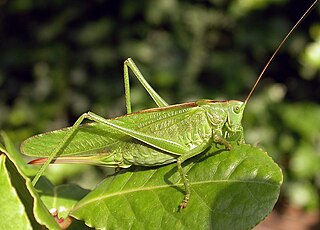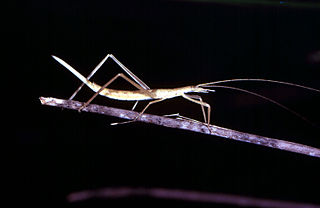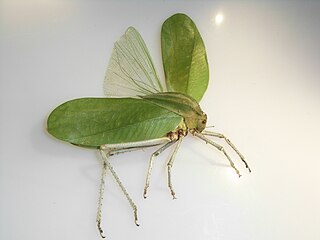
Insects in the family Tettigoniidae are commonly called katydids, or bush crickets. They have previously been known as "long-horned grasshoppers". More than 8,000 species are known. Part of the suborder Ensifera, the Tettigoniidae are the only extant (living) family in the superfamily Tettigonioidea.

Orthoptera is an order of insects that comprises the grasshoppers, locusts, and crickets, including closely related insects, such as the bush crickets or katydids and wētā. The order is subdivided into two suborders: Caelifera – grasshoppers, locusts, and close relatives; and Ensifera – crickets and close relatives.

Ensifera is a suborder of insects that includes the various types of crickets and their allies including: true crickets, camel crickets, bush crickets or katydids, grigs, weta and Cooloola monsters. This and the suborder Caelifera make up the order Orthoptera. Ensifera is believed to be a more ancient group than Caelifera, with its origins in the Carboniferous period, the split having occurred at the end of the Permian period. Unlike the Caelifera, the Ensifera contain numerous members that are partially carnivorous, feeding on other insects, as well as plants.

The Tettigoniinae are a subfamily of bush crickets or katydids, which contains hundreds of species in about twelve tribes.

Kawanaphila is a genus of insects in family Tettigoniidae from Australia. It was described in 1993 by David C. Rentz.

Zaprochilus, the twig-mimicking katydids, is a genus of bush crickets or katydids in the subfamily Zaprochilinae. They are found in Australia.

Crickets are orthopteran insects which are related to bush crickets, and, more distantly, to grasshoppers. In older literature, such as Imms, "crickets" were placed at the family level, but contemporary authorities including Otte now place them in the superfamily Grylloidea. The word has been used in combination to describe more distantly related taxa in the suborder Ensifera, such as king crickets and mole crickets.
Panoploscelis is a genus of very large insects belonging to the true katydid tribe Eucocconotini, which is a subfamily of the Tettigoniidae. Like the other members of the suborder Ensifera, Panoploscelis are part of the insect order Orthoptera, which also contains crickets, grasshoppers and locusts. Members of this genus are among the largest katydids of the Neotropics.

Tympanophora is a genus of bush-crickets, known as balloon-winged katydids, found in Australia. It is the only extant (living) genus in the subfamily Tympanophorinae.
Phyllophorella queenslandica is a species of bush crickets or katydids described in 2009. It is commonly known as the Small Hooded Katydid or Queensland Small Hooded Katydid. The species is native to Far North Queensland, from Kuranda to the Lockerbie area.

Agraeciini is a large tribe of bush crickets or katydids in the conehead subfamily, Conocephalinae.

Conocephalus strictus, the straight-lanced meadow katydid, is a species of katydid found in North America.

The Hexacentrinae, are a subfamily of predatory bush crickets or katydids. The type genus is Hexacentrus, which may be known as "balloon-winged" bush crickets/katydids etc., is also the most speciose and widespread in Africa and Asia.
Microtettigonia is a genus of bush-crickets or katydids, endemic to Western Australia and known as micro katydids. It is the only genus of the subfamily Microtettigoniinae.

Zaprochilinae is a subfamily of bush-crickets found in Australia; the type genus is Zaprochilus.

Chimarocephala is a genus of band-winged grasshoppers in the family Acrididae. There are at least three described species in Chimarocephala.

Chlorobalius is a genus in the bush cricket or katydid family containing a single species, Chlorobalius leucoviridis, commonly known as the spotted predatory katydid. C. leucoviridis is a predator and is an acoustic aggressive mimic of cicadas; by imitating the sounds and movements made by female cicadas, it lures male cicadas to within its reach and then eats them.
Alinjarria is a genus of bush-crickets including two species, one from the east of Australia and the other from the west. The genus was erected by Rentz, Su & Ueshima in 2007.
Austrophlugis is a genus of bush crickets or katydids belonging to the tribe Phlugidini. The species of this genus are found in Australia.

Siliquofera is a genus of bush cricket in the subfamily Phyllophorinae that includes only one species, Siliquofera grandis, which is fairly common and widespread in rainforest canopies of New Guinea and nearby smaller islands, and seemingly rare in Australia where only found in the remote Iron Range region. This very well-camouflaged, green and leaf-like bush cricket is one of the world's largest Orthoptera, with adults typically having a length of 10.7–13 cm (4.2–5.1 in) and a wingspan of 25–27 cm (9.8–10.6 in); it can weigh more than 30 g (1.1 oz).














